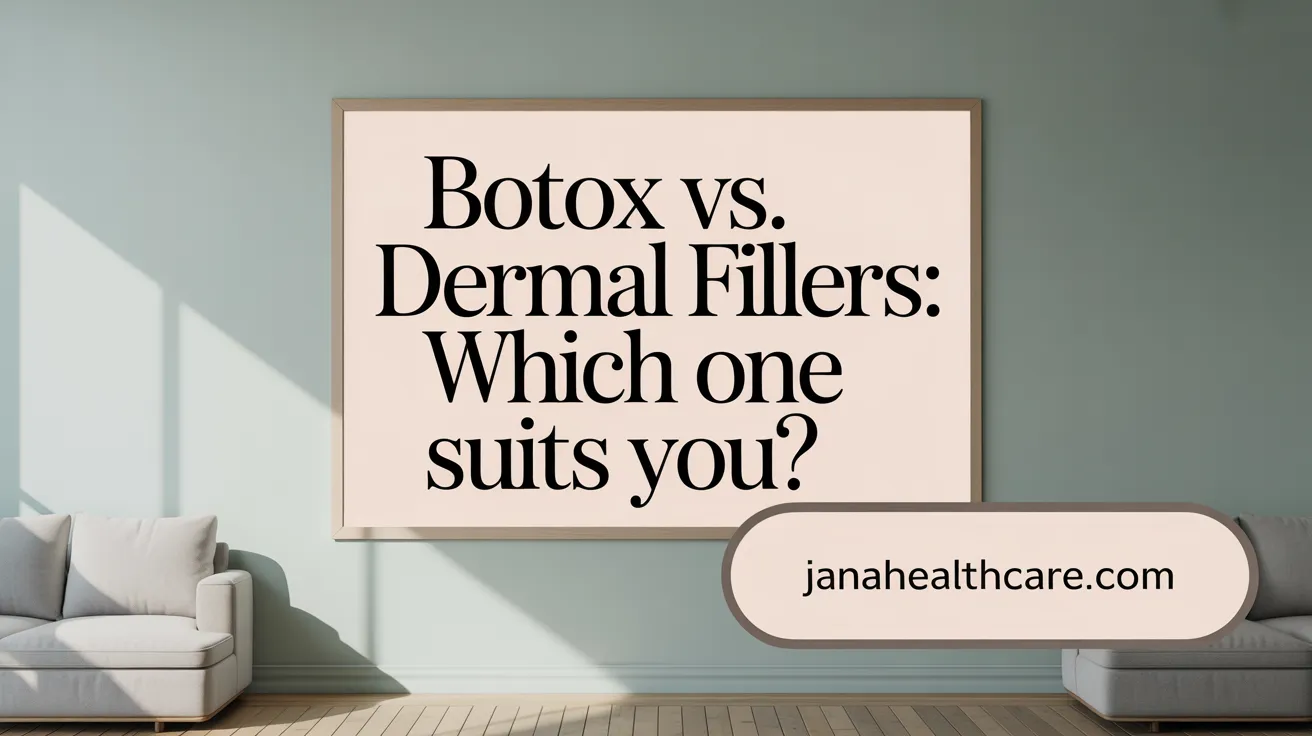Understanding Injectable Treatments for a Youthful Glow
As non-surgical cosmetic treatments soar in popularity, Botox and dermal fillers emerge as leading options to combat signs of aging. This article will guide you through their key differences, mechanisms, benefits, risks, and candidacy, empowering you to choose the injection that best aligns with your aesthetic goals.
The Fundamental Differences: Botox vs. Dermal Fillers

Purpose of Botox and fillers
Botox and dermal fillers serve different roles in facial rejuvenation. Botox is primarily used to relax muscles that cause wrinkles due to repetitive facial movements. It effectively softens dynamic wrinkles such as frown lines, crow's feet, and forehead lines. In contrast, dermal fillers are designed to restore lost volume, fill static wrinkles, and sculpt facial contours. They are often used to augment lips, cheeks, and jawlines, and to smooth deeper wrinkles that are visible at rest.
Mechanisms of action
Botox works by blocking nerve signals to specific muscles. Derived from the bacteria Clostridium botulinum, it releases a neurotoxin that cleaves proteins like SNAP-25, preventing the release of acetylcholine. This results in temporary muscle paralysis, diminishing motion-related wrinkles. Dermal fillers typically contain hyaluronic acid or other biocompatible substances that physically fill in the skin's subdermal layer. This added support replenishes volume, smooths out static wrinkles, and enhances facial features immediately after injection. Learn more about how dermal fillers work.
Types of wrinkles targeted
Botox is most effective for treating dynamic wrinkles caused by muscle movement—such as those found in the forehead, around the eyes, and between the eyebrows. It prevents these lines from forming or deepening over time. Fillers are better suited for static wrinkles, which are visible even when the face is at rest, like nasolabial folds, marionette lines, and deep creases. They are also used for volume loss in areas like the cheeks, lips, and chin.
Use in dynamic vs. static wrinkles
Dynamic wrinkles result from repetitive facial muscle activity. Botox's ability to relax muscles makes it ideal for these types of wrinkles. Static wrinkles, caused by a combination of age-related volume loss and skin laxity, are effectively addressed with fillers that restore fullness and contour. See details on dynamic and static wrinkle treatment.
Combining treatments for rejuvenation
For a comprehensive facial rejuvenation, many practitioners recommend combining Botox and dermal fillers. This approach simultaneously targets muscle movement and restores volume, resulting in a natural, youthful appearance. Botox can reduce the appearance of expression lines, while fillers provide support for sagging tissue and volume deficiencies, offering a balanced and lasting aesthetic improvement. Discover more about combining Botox and fillers.
Duration and Result Expectations: Understanding Longevity and Aesthetics

How long do the effects of Botox and dermal fillers typically last?
The effects of Botox usually persist for about 3 to 6 months, depending on various factors such as the treatment area, individual metabolism, and the amount used. Most users notice a significant reduction in wrinkles for roughly 3 to 4 months, after which muscle activity gradually returns and wrinkles may reappear. Regular injections are typically necessary to maintain the smooth appearance. Learn more about the Duration of Botox results, Duration of Botox Effects, and Duration of Botox Results.
In contrast, dermal fillers tend to last longer. Depending on the type and placement, they can provide results spanning from 6 months up to 2 years. Hyaluronic acid-based fillers like Restylane typically last between 6 to 12 months, while other formulations like JUVÉDERM Voluma in the cheeks can last 12 to 18 months or even longer. Some more durable fillers, such as poly-L-lactic acid, can last over two years by stimulating natural collagen production. Long-lasting or semi-permanent options, such as polymethylmethacrylate (PMMA), can maintain results for several years, but are generally reserved for experienced practitioners. For details, see Duration of filler results, Dermal filler longevity, and Duration of Dermal Filler Results.
Overall, both Botox and dermal fillers are temporary solutions requiring periodic retreatment to sustain desired outcomes. For more guidance, see Botox and dermal fillers duration guide.
What are the typical aesthetic results achievable with Botox and dermal fillers for facial rejuvenation?
The primary aesthetic result of Botox is a smoother and more relaxed facial expression, significantly reducing the appearance of dynamic wrinkles caused by muscle movements. These include lines on the forehead, between the eyebrows (glabellar lines), and around the eyes (crow’s feet). The effect softens the overactive muscles, leading to a more youthful and rested look. For comprehensive insights, see Botox for wrinkle elimination, Uses of Botox, and Dynamic wrinkles treatment.
Dermal fillers primarily restore volume to areas that have lost fullness over time, such as cheeks, lips, and under-eye hollows. They also fill static wrinkles and deep lines like nasolabial folds, resulting in a more contoured and balanced face. The use of fillers can improve facial symmetry, define features, and create a more youthful appearance. See Dermal fillers for volume enhancement, Facial fillers for wrinkles, and Benefits of Dermal Fillers for more information.
When combined, Botox and fillers can deliver a comprehensive facial rejuvenation. Patients often see results such as reduced fine lines, improved facial contours, and a more vibrant, youthful look. These treatments can be tailored to individual needs, whether for subtle enhancements or more dramatic improvements, ultimately delivering a natural result that enhances attractiveness and health perception. Learn about Combining Botox and fillers, Combination of Botox and Fillers, and Botox and dermal fillers for facial rejuvenation.
How do combination treatments enhance facial rejuvenation?
Using Botox and dermal fillers in tandem allows practitioners to target both static and dynamic signs of aging effectively. Botox relaxes muscles responsible for expression lines, preventing new wrinkles from forming, while fillers restore lost volume, lift sagging skin, and improve overall facial harmony. Learn more about Combining Botox and Fillers and Benefits of combination treatments.
Such combination treatments can address multiple concerns simultaneously, resulting in a more balanced and natural enhancement. For example, Botox can smooth forehead and eye wrinkles, while fillers can volumize cheeks and lips, providing an overall fresher, younger appearance. See Comprehensive facial rejuvenation with Botox and fillers and Liquid facelift explained.
Patients benefit from longer-lasting results and more comprehensive rejuvenation by combining both modalities. This approach also minimizes the need for more invasive surgical procedures and achieves subtle, natural-looking improvements tailored to each individual’s facial structure and aging pattern. Additional helpful resources include Combining Botox and fillers for best results and Non-surgical cosmetic procedures.
Who Should Consider Botox or Dermal Fillers? Candidacy and Ideal Uses
Who is a suitable candidate for Botox and dermal fillers in terms of age and skin conditions?
Suitable candidates for Botox are typically adults aged 18 and older seeking to diminish or prevent dynamic wrinkles caused by muscle movements. These include lines like frown lines, crow's feet, and forehead lines. Candidates should have good overall health, with no significant neuromuscular disorders, active skin infections, or allergies to botulinum toxin components. Botox candidacy criteria
Dermal fillers are ideal for individuals looking to restore facial volume, smooth static wrinkles, and contour features such as lips, cheeks, and jawline. They are most effective for those with moderate to severe facial folds, sunken areas, or scars, who are in good physical health and do not smoke. Both treatments are suitable for most skin types and involve minimal discomfort with quick procedures. Good filler candidate criteria
Candidates should have realistic expectations about results and understand that these treatments are temporary or semi-permanent. A thorough consultation with a qualified healthcare professional is essential to evaluate health status, skin condition, and to confirm suitability for either or both treatments. Ensuring proper assessment helps maximize safety and effectiveness, leading to natural-looking rejuvenation. Choosing a qualified injector
Treatment Areas and Costs: Knowing Where and What You Pay For

Which facial areas are commonly treated with Botox and which with dermal fillers?
Botox is frequently used to target dynamic wrinkles treatment caused by muscle movements. These include lines across the forehead, frown lines between the eyebrows (glabellar lines), crow’s feet at the corners of the eyes, bunny lines on the nose, chin dimpling, and for lifting the eyebrows or reducing neck bands. The injections are carefully placed into specific muscles to relax and diminish the appearance of these expression-related lines. In contrast, dermal fillers are primarily used to restore volume and smooth static wrinkles and volume loss. They are injected into areas like the cheeks, lips, nasolabial folds (lines running from the nose to the mouth), marionette lines (lines at the corners of the mouth), and under-eye hollows. Fillers also enhance facial contours such as the chin, jawline, or enhance the lips for a more youthful profile. While Botox effectively reduces wrinkles caused by muscle activity, fillers improve facial shape, volume, and support, addressing age-related volume depletion and static lines.
How do Botox and dermal fillers compare in terms of treatment costs?
Pricing for Botox typically ranges from about $300 to $600 per treatment session, with the cost per unit being approximately $10 to $15. Since a typical Botox treatment involves multiple units depending on the area, this can translate into an overall moderate expense, especially considering its short-term duration of 3 to 4 months. Dermal fillers generally cost more initially, with prices around $600 to $1,250 per syringe. The total cost depends on the amount of filler needed and the area treated. Fillers often provide longer-lasting results, from 6 months up to 18 months or more, which may reduce the need for frequent repeat treatments and balance out the higher per-session cost. While Botox's lower per-treatment cost and shorter effect duration may lead to more frequent visits, the longer-lasting effects of fillers can lead to fewer treatments over time. When budgeting, patients should also consider provider expertise, safety standards, and the desired aesthetic outcome. Both treatments are most effective when performed by qualified professionals to ensure safety and optimal results.
Benefits, Side Effects, and Safety: What You Need to Know

What are the typical benefits and risks associated with Botox and dermal fillers?
Botox offers several benefits such as smoothing facial wrinkles caused by muscle movements, like frown lines, forehead creases, and crow's feet. It also helps in preventing the formation of new wrinkles and can treat medical conditions like hyperhidrosis (excessive sweating) and migraines. The effects typically last about 3 to 4 months and require minimal downtime, making it a popular choice for quick facial rejuvenation.
Dermal fillers, primarily made of hyaluronic acid or other biocompatible materials, focus on restoring facial volume, filling static wrinkles, and defining features such as lips and cheeks. Their results usually last from 6 to 12 months, depending on the type and area treated. Risks associated with fillers include temporary swelling, bruising, lumps, allergic reactions, skin discoloration, and in rare cases, vascular complications if improperly injected.
Both treatments are considered safe when executed by trained professionals. They involve minimal recovery time and are effective options for those seeking non-surgical aesthetic improvements. Nevertheless, understanding their specific benefits and potential risks is essential, and discussing these with a qualified healthcare provider ensures safe and satisfactory outcomes.
What are the common side effects and safety considerations for Botox and dermal fillers?
Common side effects of Botox include bruising, swelling, mild headaches, temporary muscle weakness, eyelid drooping, and dryness or watering in the eyes. These effects are generally mild and resolve within days to weeks. For dermal fillers, typical side effects involve bruising, redness, swelling, lumps, pain, and tenderness at the injection sites, usually subsiding quickly.
Both treatments carry rare but serious risks such as vascular occlusion (blockage of blood vessels), which can lead to tissue necrosis or even blindness if blood flow is compromised during injection. Allergic reactions, although infrequent, may also occur. Ensuring safety involves choosing qualified, experienced healthcare professionals to administer these procedures. Proper patient assessment, including medical history and allergy screening, reduces risks. Patients are advised to follow pre-treatment precautions like avoiding blood-thinning medications and post-treatment guidelines such as avoiding strenuous activity and alcohol.
Overall, with proper medical care and adherence to safety protocols, Botox and dermal fillers are safe and effective options for facial rejuvenation, offering natural-looking results with minimal side effects.
Making the Choice: How to Decide Between Botox and Fillers
 When considering facial rejuvenation treatments, understanding your specific goals is the first step toward choosing the right procedure. Botox and dermal fillers serve different purposes and can even be used together for a comprehensive approach.
When considering facial rejuvenation treatments, understanding your specific goals is the first step toward choosing the right procedure. Botox and dermal fillers serve different purposes and can even be used together for a comprehensive approach.
Botox is primarily used to treat dynamic wrinkles—those that appear with muscle movement, such as frown lines, forehead lines, and crow's feet. It works by temporarily relaxing the muscles responsible for these lines, with results lasting about 3 to 4 months. This makes it ideal for smoothing expression lines caused by repetitive facial movements.
In contrast, dermal fillers are used to restore lost volume, soften static wrinkles, and improve facial contours. Made mainly from hyaluronic acid, fillers provide immediate results and can last anywhere from 6 months to over two years, depending on the type used. Fillers are especially effective for areas like the cheeks, lips, nasolabial folds, and under-eye hollows.
Choosing between these treatments involves considering your desired outcomes: if your focus is on reducing muscle-induced wrinkles and fine lines, Botox may be the better option. For restoring youthful volume and addressing deeper static lines, fillers might be more suitable. Sometimes, both treatments are combined to achieve a natural, balanced look (Combining Botox and fillers).
An important role in this decision is played by consultation. A qualified healthcare professional can assess your facial structure, skin type, aging concerns, and medical history to recommend the optimal treatment plan. They can also inform you about potential risks, side effects, and how treatment results will align with your aesthetic goals (Safety of Botox and fillers).
Patient-specific factors such as skin elasticity, budget, and personal preference should also influence your choice. While Botox might require more frequent treatments, fillers tend to have a longer-lasting effect but at a higher initial cost (Cost comparison between Botox and fillers).
Ultimately, making an informed decision involves understanding the distinct roles of Botox and fillers. A professional evaluation ensures that your selected approach is tailored to your unique needs, helping you achieve natural and satisfying results.
Your Path to a Radiant, Youthful Appearance
Botox and dermal fillers offer powerful yet distinct approaches to facial rejuvenation, each addressing unique signs of aging. Understanding their differences, benefits, risks, and candidacy can greatly improve your satisfaction with results. Whether targeting dynamic wrinkles with Botox or restoring volume with fillers, consulting with an experienced medical professional is essential to crafting a personalized treatment plan that reveals your perfect look. Combining both therapies often yields the most natural and comprehensive enhancement, helping you confidently embrace a more youthful, refreshed appearance.
